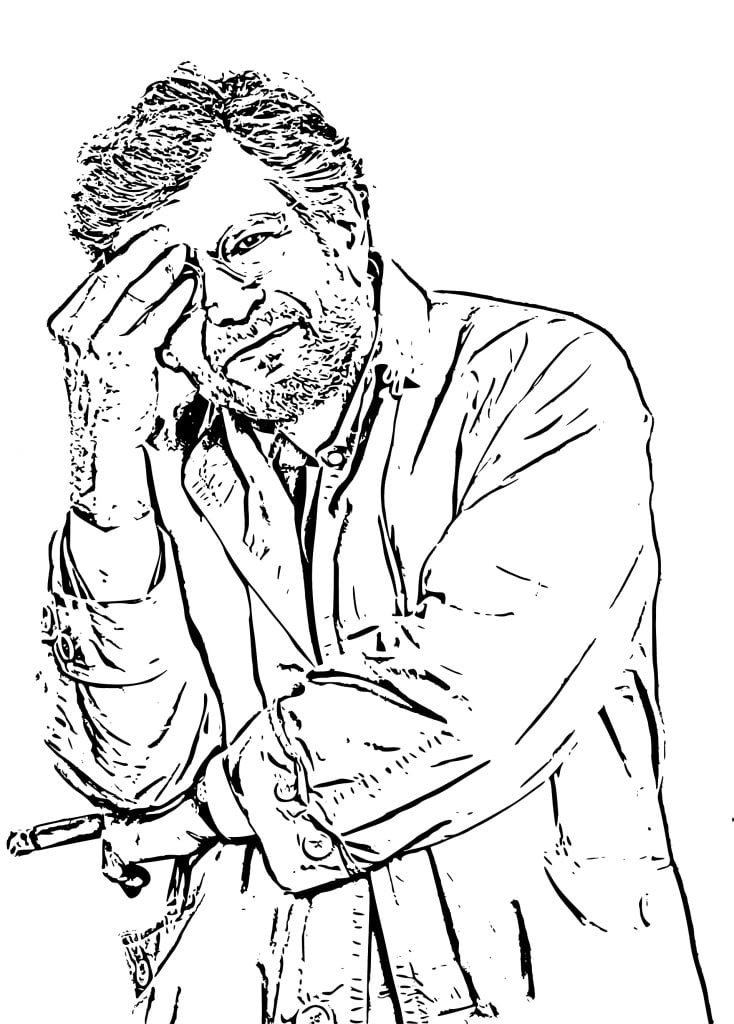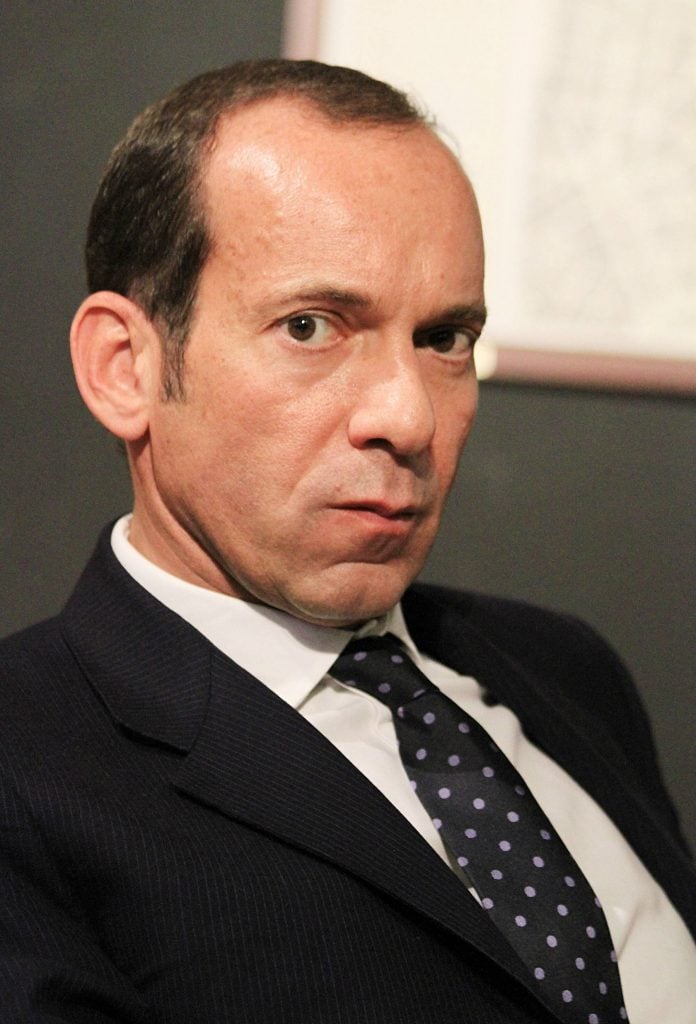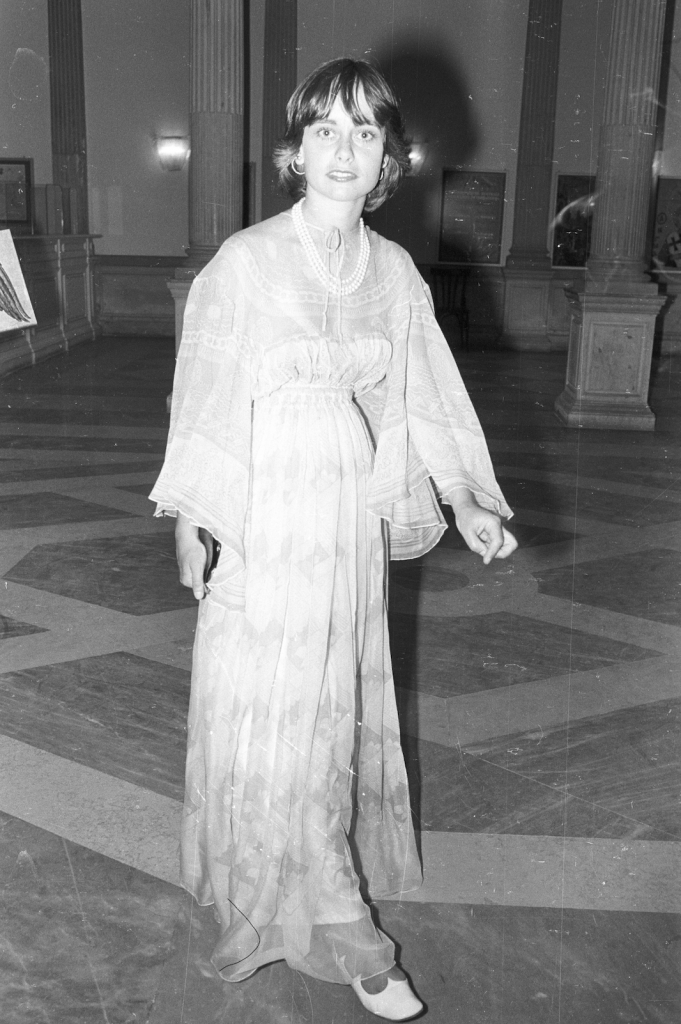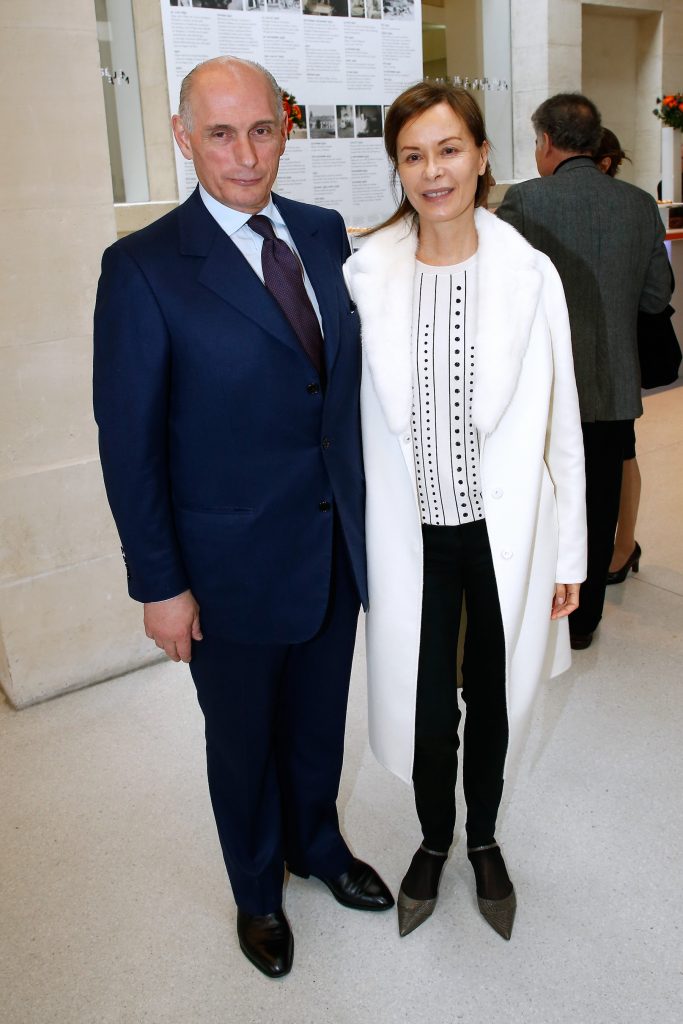Kenny Schachter
Inspector Schachter Uncovers Allegations Regarding the Latest Art World Scandal—And It’s a Doozy
Featuring Picassos and Bacons, and even an ex of King Charles, you don't want to miss this one!

Featuring Picassos and Bacons, and even an ex of King Charles, you don't want to miss this one!

Kenny Schachter

I wasn’t intending to uncover the largest, most explosive case of potential art world fraud since Inigo Philbrick (who’s set for earlier release than previously announced, handily coinciding with a BBC documentary already in production)—but I have.
Chasing leads in the last few months, I began to feel like Columbo, the famed TV detective played by Peter Falk, whose trademarks include his rumpled raincoat, cigar, and catchphrase, “Just one more thing,” as he turns to ask a final, critical question that ultimately cracks the case. (Incidentally, Falk also happened to make art, as well!)
At the heart of the scandal is the Dynamic Art Museum/DART (if ever a name that would give rise to cause for concern!), founded in 2020 by one Pier Giulio Lanza. This is a “museum” based in Milan, with tentacles spanning half a dozen countries, boasting that it was the first museum to exhibit NFTs (not true) and that it “always shows new artworks,” eschewing a permanent collection. It seems it also has tens of millions of dollars of art that has been put up as collateral with upstart Art Lending, Inc., a 2019 offshoot of an alternative asset investment boutique, Shinnecock Partners.
Incidentally, besides being managing director and founder of DART, Pier Giulio Lanza is also owner and founder of Cielo Infinito (Infinite Sky) a “vertical cemetery business,” which, in 2014, announced plans to build Italy’s first cemetery skyscraper—a 33-story futuristic tower with space for up to 60,000 graves in Verona, Shakespeare’s backdrop for Romeo and Juliet.

As if straight out of the cast of the latest Bond film, meet Pier Giulio Lanza, founder of Milan’s Dynamic Art Museum, that dynamically financed a load of art it never got around to fully paying for. Image courtesy of IMAGO / Milestone Medi
No, you certainly cannot make up a tale as far-fetched as this (well, I couldn’t), but I digress… I have uncovered transactions showing how schemes relating to DART have entangled art dealers, gallerists, and collectors from France, the U.K., Switzerland, and the USA, involving multiple paintings by Pablo Picasso and Lucio Fontana, and additional works by Francis Bacon, Umberto Boccioni, Piero Manzoni, Guido Reni, Titian, Giacomo Bala, Théodore Gericault, Fernand Léger, El Greco, and many more.
Here’s the crux of the allegations at issue, including those detailed in a pending federal court lawsuit in New Jersey: An agent would introduce art dealers to Lanza based on his status as director of DART. DART would then strike deals to purchase artworks, which were bought pursuant to installment invoices. After an initial down payment was made—sometimes more than one—the works were transferred to established storage companies, under the auspices of the original sellers, a customary practice in the industry.
The alleged pretext (more accurately, ruse) under which ownership of the art was purportedly illegally converted involved arranging viewings with associates of Lanza and/or supposed donors to his institution. The demand to have the art viewed at a convenient location for these “donors” allowed DART, or their agents, to shuffle the paintings between various warehouses across different jurisdictions such as Fracassi in Italy, Art Logistics in London, and SRI Art Services in New Jersey, with the permission of the original owners—as title had not yet been transferred, pending final payments for the art.
While moving between warehouses, DART allegedly would manage, via sleights of hand, to gain custody of the artworks while in storage. The exact mechanisms are murky (in one U.K. case involving the Francis Bacon, the case is sealed). But the allegations are spelled out plainly in the lawsuit in New Jersey, AUGUST URIBE FINE ART, LLC, Plaintiff, v. DARTMILANO SRL, et al., Defendants, in United States District Court, D. New Jersey, a case involving an approximately $6 million Picasso.
Co-defendants in the Uribe litigation alongside Lanza are his partner Riccardo Manfrin and Oblyon Group, LLC, founded by Italian-Spaniard Marco Mercanti, a company that proclaims to be advisors, loan finders, and brokers.
In the particular instance of Uribe, his complaint sets out a tale of DART/Lanza’s subterfuge in transferring ownership to his own control that is a transformative act of wizardry that could cause the egos of Houdini, David Copperfield, David Blaine, and Criss Angel to vanish with the single wave of a wand. Wow.
Enter Alan Snyder, founder of Shinnecock Partners and Art Lending, Inc. You can see him, looking like a character from central casting, in a YouTube video advertising his services as a cross between an old school used car salesman and a carny snake oil huckster, paying lip service to “anal due diligence” in assessing provenance and avoiding “bad actors.” In the shambolic video, Snyder—all that’s missing is a plaid sports jacket—boasts of loaning to an unnamed museum in Milan, stating, “I don’t know of any investment better!”, in which you can “outperform every money manager out there!”
Snyder, despite pledges to spread out the risk in Art Lending’s portfolio, advanced DART/Lanza a sizable loan, in excess of $25 million (according to Lanza himself, via our recent telephone conversation), based on a basket of works said to be valued at up to $52 million in another legal filing I have seen. According to Uribe’s complaint, a week after Oblyon took control of the work, it was “transferred from Oblyon to Art Lending” at the warehouse, which then refused to release it because Art Lending “maintains a lien despite the fact that DART didn’t have title.” Art Lending apparently lent the money to DART under the belief that DART owned the paintings in full, has denied any wrongdoing, and filed a counterclaim against DART in the Uribe litigation.
Incredibly, Uribe’s complaint says that in February 2022, he was “contacted by another art seller who was shopping the Artwork and offering to sell the Artwork to UFA for millions of dollars more than DART had agreed to pay for it.” According to the complaint, it was only at that time that Uribe realized that custody of the work had been “transferred to Art Lending via Oblyon…” so that DART could use the Artwork “as collateral for a loan from Art Lending” and the painting could be “flipped” for a large profit.
Since September, I have spoken to the alleged perpetrator, Pier Giulio Lanza, and many of his victims (and their respective counsels); the mess is nothing short of devastating, and, in its wake, has left some financially reeling.
Additional marks include Camilla Blaffer, a scion of Houston’s Blaffer family, major contributors to the Museum of Fine Arts there, part of which carries their name, with extensive holdings of art and family oil ties leading back to the inception of Exxon and Texaco corporations; and dealers from America to Europe (and Switzerland), among them Almine Rech and London’s Nevill Keating Pictures.
Camilla (Coco) Blaffer (who is best known for, more than 30 years ago, purchasing a “dusty old painting” from a French auction house that turned out to be an El Greco) claims to have lost a Léger painting to DART. It is believed to be a giant work on paper, mounted to canvas, called La Danse Sao Paulo (plainly visible in the still from the metaverse video referenced below). Coco Blaffer asserts she was defrauded by DART and mentioned of hearing of others similarly wronged.

Lady Angela Nevill at the “Save Venice” ball in Venice, 1974 (Photo by Fairchild Archive/WWD/Penske Media via Getty Images)
Also seemingly a victim of DART: Lady Angela Nevill Keating, formerly chairman of the Society of London Art Dealers from 2001 to 2005, daughter of Lord Rupert Nevill, private secretary to Prince Philip, and sister of the 6th Marquess of Abergavenny (she also happens to have dated King Charles and served as bridesmaid to HRH Princess Margaret). She founded Nevill Keating Pictures in the 1970s with William Keating, her late husband. In response to a query, Nevill Keating partner Rupert Boswall wrote me this:
Dear Mr Schachter
Lady Nevill has asked me to thank you for the sympathy expressed in your email of 20 November 2023. She has asked me to reply on behalf of Nevill Keating Pictures Limited (NKPL).
NKPL only wishes to make a short statement.
NKPL was introduced to Dart Milano by a trusted intermediary as a reputable buyer. Dart Milano was interested to buy La Femme Assise by Picasso, owned by a collector well known to NKPL. NKPL entered a back to back contract but Dart Milano failed to complete the transaction which was therefore cancelled. Title remained with the owner.
Without NKPL’s permission or knowledge the painting was moved whilst in storage in New Jersey and has become the subject of a legal claim by Art Lending, an entity unknown to NKPL. NKPL believes unencumbered title remains with the original owner and that Art Lending has no valid claim.
Almine Rech, possibly with the involvement of her husband Bernard Ruiz-Picasso and/or The Fundación Almine y Bernard Ruiz-Picasso para el Arte, a foundation created in 2002 and comprised of a collection of works by Pablo Picasso and contemporary artists, is also entangled with DART. Specifically, Rech is said to have two Picasso paintings caught in the apparent con. Rech brusquely replied to my text query: “I can’t say anything it’s all in lawyers hands.”

Bernard Ruiz-Picasso and Almine Rech attend the “Olga Picasso” Exhibition pivate view at Musee national Picasso-Paris on March 20, 2017 in Paris, France. (Photo by Bertrand Rindoff Petroff/Getty Images)
Beyond the web of attorneys—never a good thing, trust me—the Italian police may have begun looking into the matter. DART has aggressively fought the Uribe litigation, even filing a motion contesting jurisdiction by the New Jersey court on the basis that the agreement between DART and Uribe was supposedly procured by fraudulent statements that Uribe owned the work (an argument contested by Uribe). .
One person I have spoken to, exposed to the alleged DART/Lanza scheme, spoke of another seller that was able to claw back their artwork, which in this case was warehoused in Lugano, Switzerland. In the process of unpackaging the painting, a bogus invoice was allegedly found amongst the attendant documentation, falsely claiming the entirety of the purchase price had been paid by DART. Another claimant in the sealed lawsuit pending in the UK also asserted that there was a forged invoice indicating the work had been fully paid for when it had not.
When I corresponded with Pier Giulio Lanza via Instagram Direct Message, he wrote that I had “better check carefully what is going to be reported” since “there are already a lot of misrepresentations”:
Since topic is quite delicate I would suggest to be conservative and better wait for the end. We both have legal office at works….If you write you better check first carefully….We can talk if you want but as I said we are closing a deal for over 50 ml dollars…I need to avoiding any possible issue to the deal…But again we know exactly how the things are and we have all the evidence…As I said in order to avoid legal issue better be conservative
Of course, as much as it particularly pains me to say, the foundation of the Dynamic Art museum was—no surprise here—not a physical museum but an entity built on crypto, NFTs, and the metaverse, where you can spot some of the purportedly purloined works, in all their glory (see accompanying video still).

Of course, a fraud of this scale nowadays wouldn’t be complete without an NFT show in China and an online Instagram flex showcasing purloined pictures from the alleged fraud…here in a scene from the Dynamic Art Museum metaverse.
Also, no shocker that Alan Snyder’s Shinnecock Partners and Art Lending naively jumped into waters entirely ill prepared to wade amongst the sharks and other ruthless market mavens, lured by the age-old, hopelessly foolish (greedy) notion of making an easy buck in the art world. Yes, it is all too easy to acquire art in the first instance—you could spend a billion on art at any given Basel fair without so much as shaking hands, a nod will do—but a successful exit strategy, i.e. selling well, is an altogether different can of worms.